在8.1 節(jié)中,我們提到大型數(shù)據(jù)集是深度神經(jīng)網(wǎng)絡(luò)在各種應(yīng)用中取得成功的先決條件。圖像增強在對訓(xùn)練圖像進行一系列隨機變化后生成相似但不同的訓(xùn)練示例,從而擴大了訓(xùn)練集的大小。或者,圖像增強的動機可能是訓(xùn)練示例的隨機調(diào)整允許模型減少對某些屬性的依賴,從而提高它們的泛化能力。例如,我們可以通過不同的方式裁剪圖像,使感興趣的對象出現(xiàn)在不同的位置,從而減少模型對對象位置的依賴。我們還可以調(diào)整亮度和顏色等因素,以降低模型對顏色的敏感度。圖像增強對于當時 AlexNet 的成功來說可能是不可或缺的。在本節(jié)中,我們將討論這種在計算機視覺中廣泛使用的技術(shù)。
%matplotlib inline import torch import torchvision from torch import nn from d2l import torch as d2l
%matplotlib inline from mxnet import autograd, gluon, image, init, np, npx from mxnet.gluon import nn from d2l import mxnet as d2l npx.set_np()
14.1.1。常見的圖像增強方法
在我們對常見圖像增強方法的研究中,我們將使用以下方法400×500形象一個例子。
d2l.set_figsize()
img = d2l.Image.open('../img/cat1.jpg')
d2l.plt.imshow(img);

d2l.set_figsize() img = image.imread('../img/cat1.jpg') d2l.plt.imshow(img.asnumpy());
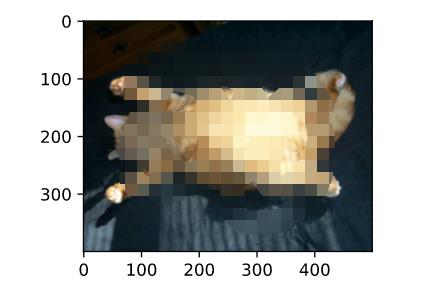
大多數(shù)圖像增強方法都具有一定的隨機性。為了方便我們觀察圖像增強的效果,接下來我們定義一個輔助函數(shù)apply。aug此函數(shù)在輸入圖像上多次運行圖像增強方法img 并顯示所有結(jié)果。
def apply(img, aug, num_rows=2, num_cols=4, scale=1.5): Y = [aug(img) for _ in range(num_rows * num_cols)] d2l.show_images(Y, num_rows, num_cols, scale=scale)
def apply(img, aug, num_rows=2, num_cols=4, scale=1.5): Y = [aug(img) for _ in range(num_rows * num_cols)] d2l.show_images(Y, num_rows, num_cols, scale=scale)
14.1.1.1。翻轉(zhuǎn)和裁剪
左右翻轉(zhuǎn)圖像通常不會改變對象的類別。這是最早和最廣泛使用的圖像增強方法之一。接下來,我們使用該transforms模塊創(chuàng)建實例RandomHorizontalFlip,它以 50% 的幾率左右翻轉(zhuǎn)圖像。
apply(img, torchvision.transforms.RandomHorizontalFlip())
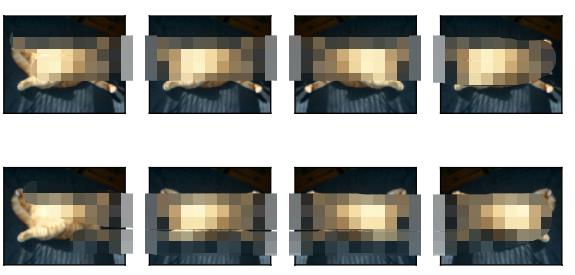
上下翻轉(zhuǎn)不像左右翻轉(zhuǎn)那樣常見。但至少對于這個示例圖像,上下翻轉(zhuǎn)并不妨礙識別。接下來,我們創(chuàng)建一個RandomVerticalFlip實例,以 50% 的幾率上下翻轉(zhuǎn)圖像。
apply(img, torchvision.transforms.RandomVerticalFlip())
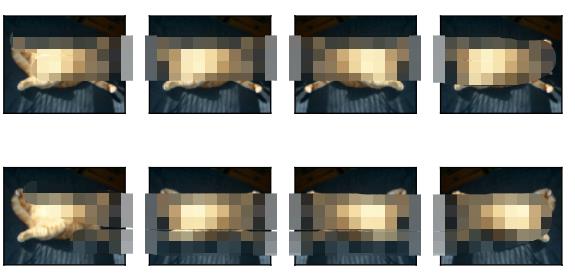
Flipping the image left and right usually does not change the category of the object. This is one of the earliest and most widely used methods of image augmentation. Next, we use the transforms module to create the RandomFlipLeftRight instance, which flips an image left and right with a 50% chance.
apply(img, gluon.data.vision.transforms.RandomFlipLeftRight())
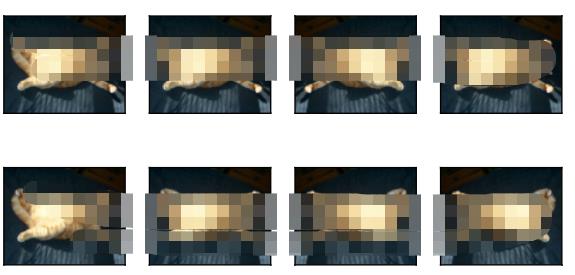
Flipping up and down is not as common as flipping left and right. But at least for this example image, flipping up and down does not hinder recognition. Next, we create a RandomFlipTopBottom instance to flip an image up and down with a 50% chance.
apply(img, gluon.data.vision.transforms.RandomFlipTopBottom())
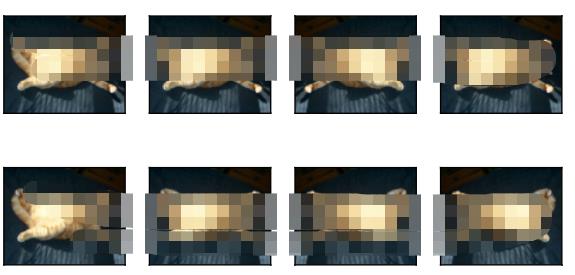
在我們使用的示例圖像中,貓位于圖像的中間,但一般情況下可能并非如此。在7.5 節(jié)中,我們解釋了池化層可以降低卷積層對目標位置的敏感性。此外,我們還可以隨機裁剪圖像,讓物體以不同的尺度出現(xiàn)在圖像中的不同位置,這樣也可以降低模型對目標位置的敏感度。
在下面的代碼中,我們隨機裁剪一個面積為 10%~100%每次都是原始區(qū)域的大小,這個區(qū)域的寬高比是隨機選擇的 0.5~2. 然后,該區(qū)域的寬度和高度都縮放為 200 像素。除非另有說明,之間的隨機數(shù)a和b本節(jié)中指的是從區(qū)間中隨機均勻采樣得到的連續(xù)值 [a,b].
shape_aug = torchvision.transforms.RandomResizedCrop( (200, 200), scale=(0.1, 1), ratio=(0.5, 2)) apply(img, shape_aug)
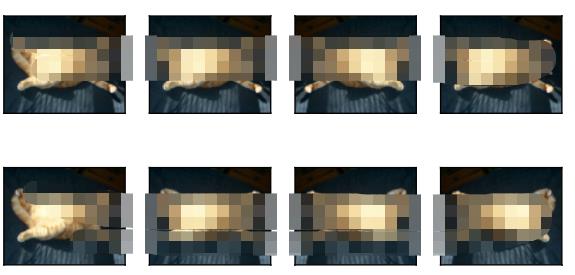
shape_aug = gluon.data.vision.transforms.RandomResizedCrop( (200, 200), scale=(0.1, 1), ratio=(0.5, 2)) apply(img, shape_aug)

14.1.1.2。改變顏色
另一種增強方法是改變顏色。我們可以改變圖像顏色的四個方面:亮度、對比度、飽和度和色調(diào)。在下面的示例中,我們將圖像的亮度隨機更改為 50% (1?0.5) 和 150% (1+0.5) 的原始圖像。
apply(img, torchvision.transforms.ColorJitter( brightness=0.5, contrast=0, saturation=0, hue=0))
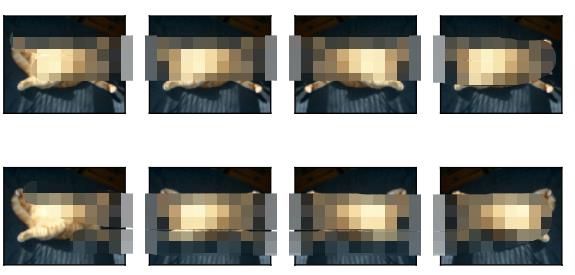
apply(img, gluon.data.vision.transforms.RandomBrightness(0.5))
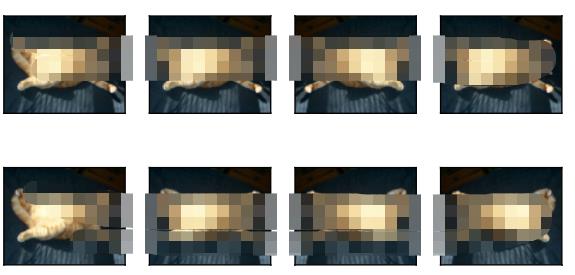
同樣,我們可以隨機改變圖像的色調(diào)。
apply(img, torchvision.transforms.ColorJitter( brightness=0, contrast=0, saturation=0, hue=0.5))
apply(img, gluon.data.vision.transforms.RandomHue(0.5))
我們也可以創(chuàng)建一個RandomColorJitter實例,同時設(shè)置如何隨機改變圖片的brightness, contrast, saturation, 。hue
color_aug = torchvision.transforms.ColorJitter( brightness=0.5, contrast=0.5, saturation=0.5, hue=0.5) apply(img, color_aug)
color_aug = gluon.data.vision.transforms.RandomColorJitter( brightness=0.5, contrast=0.5, saturation=0.5, hue=0.5) apply(img, color_aug)
14.1.1.3。結(jié)合多種圖像增強方法
在實踐中,我們將結(jié)合多種圖像增強方法。例如,我們可以組合上面定義的不同圖像增強方法,并通過實例將它們應(yīng)用于每個圖像Compose。
augs = torchvision.transforms.Compose([ torchvision.transforms.RandomHorizontalFlip(), color_aug, shape_aug]) apply(img, augs)
augs = gluon.data.vision.transforms.Compose([ gluon.data.vision.transforms.RandomFlipLeftRight(), color_aug, shape_aug]) apply(img, augs)
14.1.2。圖像增強訓(xùn)練
讓我們訓(xùn)練一個具有圖像增強功能的模型。這里我們使用 CIFAR-10 數(shù)據(jù)集而不是我們之前使用的 Fashion-MNIST 數(shù)據(jù)集。這是因為 Fashion-MNIST 數(shù)據(jù)集中物體的位置和大小已經(jīng)歸一化,而 CIFAR-10 數(shù)據(jù)集中物體的顏色和大小有更顯著的差異。CIFAR-10 數(shù)據(jù)集中的前 32 個訓(xùn)練圖像如下所示。
all_images = torchvision.datasets.CIFAR10(train=True, root="../data", download=True) d2l.show_images([all_images[i][0] for i in range(32)], 4, 8, scale=0.8);
Downloading https://www.cs.toronto.edu/~kriz/cifar-10-python.tar.gz to ../data/cifar-10-python.tar.gz
0%| | 0/170498071 [00:00
Extracting ../data/cifar-10-python.tar.gz to ../data
d2l.show_images(gluon.data.vision.CIFAR10( train=True)[:32][0], 4, 8, scale=0.8);
為了在預(yù)測過程中獲得確定的結(jié)果,我們通常只對訓(xùn)練樣例進行圖像增強,而不會在預(yù)測過程中使用帶有隨機操作的圖像增強。這里我們只使用最簡單的隨機左右翻轉(zhuǎn)的方法。此外,我們使用 ToTensor實例將一小批圖像轉(zhuǎn)換為深度學(xué)習(xí)框架所需的格式,即 0 到 1 之間的 32 位浮點數(shù),形狀為(批量大小,通道數(shù),高度,寬度).
train_augs = torchvision.transforms.Compose([ torchvision.transforms.RandomHorizontalFlip(), torchvision.transforms.ToTensor()]) test_augs = torchvision.transforms.Compose([ torchvision.transforms.ToTensor()])
接下來,我們定義一個輔助函數(shù)以方便讀取圖像和應(yīng)用圖像增強。PyTorch 數(shù)據(jù)集提供的參數(shù)transform應(yīng)用增強來轉(zhuǎn)換圖像。詳細介紹DataLoader請參考 4.2節(jié)。
def load_cifar10(is_train, augs, batch_size):
dataset = torchvision.datasets.CIFAR10(root="../data", train=is_train,
transform=augs, download=True)
dataloader = torch.utils.data.DataLoader(dataset, batch_size=batch_size,
shuffle=is_train, num_workers=d2l.get_dataloader_workers())
return dataloader
train_augs = gluon.data.vision.transforms.Compose([ gluon.data.vision.transforms.RandomFlipLeftRight(), gluon.data.vision.transforms.ToTensor()]) test_augs = gluon.data.vision.transforms.Compose([ gluon.data.vision.transforms.ToTensor()])
Next, we define an auxiliary function to facilitate reading the image and applying image augmentation. The transform_first function provided by Gluon’s datasets applies image augmentation to the first element of each training example (image and label), i.e., the image. For a detailed introduction to DataLoader, please refer to Section 4.2.
def load_cifar10(is_train, augs, batch_size):
return gluon.data.DataLoader(
gluon.data.vision.CIFAR10(train=is_train).transform_first(augs),
batch_size=batch_size, shuffle=is_train,
num_workers=d2l.get_dataloader_workers())
14.1.2.1。多 GPU 訓(xùn)練
我們在 CIFAR-10 數(shù)據(jù)集上訓(xùn)練第 8.6 節(jié)中的 ResNet-18 模型。回想一下13.6 節(jié)中對多 GPU 訓(xùn)練的介紹 。在下文中,我們定義了一個函數(shù)來使用多個 GPU 訓(xùn)練和評估模型。
#@save def train_batch_ch13(net, X, y, loss, trainer, devices): """Train for a minibatch with multiple GPUs (defined in Chapter 13).""" if isinstance(X, list): # Required for BERT fine-tuning (to be covered later) X = [x.to(devices[0]) for x in X] else: X = X.to(devices[0]) y = y.to(devices[0]) net.train() trainer.zero_grad() pred = net(X) l = loss(pred, y) l.sum().backward() trainer.step() train_loss_sum = l.sum() train_acc_sum = d2l.accuracy(pred, y) return train_loss_sum, train_acc_sum #@save def train_ch13(net, train_iter, test_iter, loss, trainer, num_epochs, devices=d2l.try_all_gpus()): """Train a model with multiple GPUs (defined in Chapter 13).""" timer, num_batches = d2l.Timer(), len(train_iter) animator = d2l.Animator(xlabel='epoch', xlim=[1, num_epochs], ylim=[0, 1], legend=['train loss', 'train acc', 'test acc']) net = nn.DataParallel(net, device_ids=devices).to(devices[0]) for epoch in range(num_epochs): # Sum of training loss, sum of training accuracy, no. of examples, # no. of predictions metric = d2l.Accumulator(4) for i, (features, labels) in enumerate(train_iter): timer.start() l, acc = train_batch_ch13( net, features, labels, loss, trainer, devices) metric.add(l, acc, labels.shape[0], labels.numel()) timer.stop() if (i + 1) % (num_batches // 5) == 0 or i == num_batches - 1: animator.add(epoch + (i + 1) / num_batches, (metric[0] / metric[2], metric[1] / metric[3], None)) test_acc = d2l.evaluate_accuracy_gpu(net, test_iter) animator.add(epoch + 1, (None, None, test_acc)) print(f'loss {metric[0] / metric[2]:.3f}, train acc ' f'{metric[1] / metric[3]:.3f}, test acc {test_acc:.3f}') print(f'{metric[2] * num_epochs / timer.sum():.1f} examples/sec on ' f'{str(devices)}')
#@save
def train_batch_ch13(net, features, labels, loss, trainer, devices,
split_f=d2l.split_batch):
"""Train for a minibatch with multiple GPUs (defined in Chapter 13)."""
X_shards, y_shards = split_f(features, labels, devices)
with autograd.record():
pred_shards = [net(X_shard) for X_shard in X_shards]
ls = [loss(pred_shard, y_shard) for pred_shard, y_shard
in zip(pred_shards, y_shards)]
for l in ls:
l.backward()
# The `True` flag allows parameters with stale gradients, which is useful
# later (e.g., in fine-tuning BERT)
trainer.step(labels.shape[0], ignore_stale_grad=True)
train_loss_sum = sum([float(l.sum()) for l in ls])
train_acc_sum = sum(d2l.accuracy(pred_shard, y_shard)
for pred_shard, y_shard in zip(pred_shards, y_shards))
return train_loss_sum, train_acc_sum
#@save
def train_ch13(net, train_iter, test_iter, loss, trainer, num_epochs,
devices=d2l.try_all_gpus(), split_f=d2l.split_batch):
"""Train a model with multiple GPUs (defined in Chapter 13)."""
timer, num_batches = d2l.Timer(), len(train_iter)
animator = d2l.Animator(xlabel='epoch', xlim=[1, num_epochs], ylim=[0, 1],
legend=['train loss', 'train acc', 'test acc'])
for epoch in range(num_epochs):
# Sum of training loss, sum of training accuracy, no. of examples,
# no. of predictions
metric = d2l.Accumulator(4)
for i, (features, labels) in enumerate(train_iter):
timer.start()
l, acc = train_batch_ch13(
net, features, labels, loss, trainer, devices, split_f)
metric.add(l, acc, labels.shape[0], labels.size)
timer.stop()
if (i + 1) % (num_batches // 5) == 0 or i == num_batches - 1:
animator.add(epoch + (i + 1) / num_batches,
(metric[0] / metric[2], metric[1] / metric[3],
None))
test_acc = d2l.evaluate_accuracy_gpus(net, test_iter, split_f)
animator.add(epoch + 1, (None, None, test_acc))
print(f'loss {metric[0] / metric[2]:.3f}, train acc '
f'{metric[1] / metric[3]:.3f}, test acc {test_acc:.3f}')
print(f'{metric[2] * num_epochs / timer.sum():.1f} examples/sec on '
f'{str(devices)}')
現(xiàn)在我們可以定義train_with_data_aug函數(shù)來訓(xùn)練帶有圖像增強的模型。該函數(shù)獲取所有可用的 GPU,使用 Adam 作為優(yōu)化算法,對訓(xùn)練數(shù)據(jù)集應(yīng)用圖像增強,最后調(diào)用train_ch13剛剛定義的函數(shù)來訓(xùn)練和評估模型。
batch_size, devices, net = 256, d2l.try_all_gpus(), d2l.resnet18(10, 3) net.apply(d2l.init_cnn) def train_with_data_aug(train_augs, test_augs, net, lr=0.001): train_iter = load_cifar10(True, train_augs, batch_size) test_iter = load_cifar10(False, test_augs, batch_size) loss = nn.CrossEntropyLoss(reduction="none") trainer = torch.optim.Adam(net.parameters(), lr=lr) net(next(iter(train_iter))[0]) train_ch13(net, train_iter, test_iter, loss, trainer, 10, devices)
batch_size, devices, net = 256, d2l.try_all_gpus(), d2l.resnet18(10)
net.initialize(init=init.Xavier(), ctx=devices)
def train_with_data_aug(train_augs, test_augs, net, lr=0.001):
train_iter = load_cifar10(True, train_augs, batch_size)
test_iter = load_cifar10(False, test_augs, batch_size)
loss = gluon.loss.SoftmaxCrossEntropyLoss()
trainer = gluon.Trainer(net.collect_params(), 'adam',
{'learning_rate': lr})
train_ch13(net, train_iter, test_iter, loss, trainer, 10, devices)
讓我們使用基于隨機左右翻轉(zhuǎn)的圖像增強來訓(xùn)練模型。
train_with_data_aug(train_augs, test_augs, net)
loss 0.224, train acc 0.922, test acc 0.820 3237.5 examples/sec on [device(type='cuda', index=0), device(type='cuda', index=1)]
train_with_data_aug(train_augs, test_augs, net)
loss 0.168, train acc 0.942, test acc 0.837 1933.3 examples/sec on [gpu(0), gpu(1)]
14.1.3。概括
圖像增強是在現(xiàn)有訓(xùn)練數(shù)據(jù)的基礎(chǔ)上生成隨機圖像,以提高模型的泛化能力。
為了在預(yù)測過程中獲得確定的結(jié)果,我們通常只對訓(xùn)練樣例進行圖像增強,而不會在預(yù)測過程中使用帶有隨機操作的圖像增強。
深度學(xué)習(xí)框架提供了許多不同的圖像增強方法,可以同時應(yīng)用。
14.1.4。練習(xí)
在不使用圖像增強的情況下訓(xùn)練模型: 。比較使用和不使用圖像增強時的訓(xùn)練和測試準確性。這個對比實驗?zāi)芊裰С謭D像增強可以減輕過擬合的論點?為什么?train_with_data_aug(test_augs, test_augs)
在 CIFAR-10 數(shù)據(jù)集的模型訓(xùn)練中結(jié)合多種不同的圖像增強方法。它會提高測試準確性嗎?
參考深度學(xué)習(xí)框架的在線文檔。它還提供了哪些其他圖像增強方法?
-
圖像增強
+關(guān)注
關(guān)注
0文章
54瀏覽量
10038 -
pytorch
+關(guān)注
關(guān)注
2文章
808瀏覽量
13240
發(fā)布評論請先 登錄
相關(guān)推薦
圖像的對數(shù)增強問題
Pytorch模型訓(xùn)練實用PDF教程【中文】
如何設(shè)計基于FPGA的彩色圖像增強系統(tǒng)?
在Ubuntu 18.04 for Arm上運行的TensorFlow和PyTorch的Docker映像
詳解各種圖像數(shù)據(jù)增強技術(shù)
基于Retinex圖像增強
使用PyTorch提取CNNs圖像特征
13種圖像增強技術(shù)的pytorch實現(xiàn)方法
基于PyTorch的圖像數(shù)據(jù)增強技術(shù)
PyTorch教程4.2之圖像分類數(shù)據(jù)集





 PyTorch教程-14.1. 圖像增強
PyTorch教程-14.1. 圖像增強
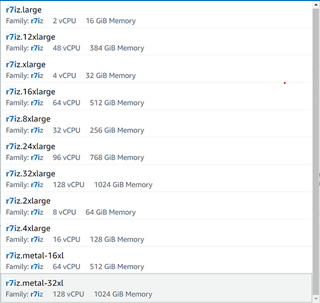










評論